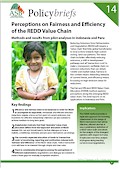| Leaflet |
 |
|
| Title | Perceptions of Fairness and Efficiency of the REDD Value Chain | | Author | Sandra J.Velarde, Meine van Noordwijk and Suyanto (eds) | | Year | 2009 | | Publisher | ASB Partnership for the Tropical Forest Margins | | City | Nairobi, Kenya | | Call Number | LE0162-09 | | Notes | ASB Policy Brief No. 14 |
|
| Abstract: |
| Reducing Emissions from Deforestation and Degradation (REDD) will require a ‘value chain’ that links global beneficiaries to local actions towards high carbonstoring land use patterns. The value chain includes: effectively reducing emissions, a shift in development pathways and all ‘transaction costs’ to make a transparent, verifiable claim on emission reductions that can obtain ‘credits’ and market value. Fairness in
this context means rewarding stewards of current forests, and efficiency means focussing on high-emission areas for reductions.
The Fair and Efficient REDD Value Chain Allocation (FERVA) method explores perceptions along the emerging REDD value chain. This brief reports on its applications in Indonesia and Peru. |
|
|
Download file(s): Click icon to download/open file.
|
| |
File Size |
Description |

|
357 KB |
Softcopy |
|
|
GRP 5: Improving the ability of farmers, ecosystems & governments to cope with climate change
GRP 6: Developing policies and incentives for multifunctional landscapes with trees that provide environmental services
|
| Viewed in 3039 times. Downloaded in 658 times. |